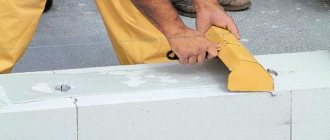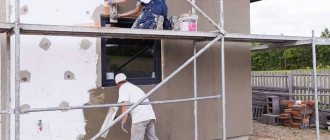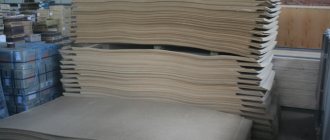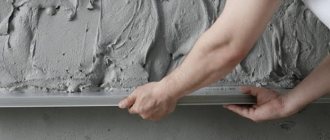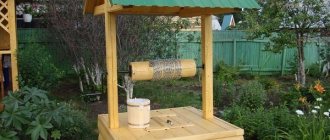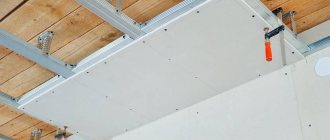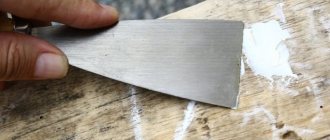09/04/2019 Porous building materials, such as aerated concrete and foam concrete, require the use of special plastering technology. Their incredibly high water absorption capacity complicates the finishing process. Every professional builder has his own secrets. Using them, even a beginner can cope with the task of plastering and filling walls made of cellular concrete. We will simply tell you now about the main features of the choice of materials for finishing aerated concrete, foam concrete and plasterboard, as well as their application.
Types of primers
Depending on the method of exposure and the type of coating formed, all brands are conventionally divided into:
- Deep penetration emulsions are the most popular and widespread, having a universal scope of application.
- Surface, providing a dense film, complicating the plastering process and used when it is necessary to protect against intense moisture influences.
In general, the classification is conditional, depending on the functions performed, they are divided into universal (providing comprehensive protection of foam concrete blocks) and specialized (strengtheners, water repellents, antiseptics, tinted to prepare walls for decorative plaster). The first group is more common and economical, the second are more expensive and must be justified.
Review of popular brands
Wall primer compositions are produced by trusted domestic and foreign manufacturers. The best reviews are observed for the brands Knauf, Ivsil, Unis, Ceresit, Vetonit, Volma, Dali and Starateli.
Most of them have a universal scope of application and are suitable not only for working with porous concrete, but also for any other mineral surfaces.
1. Ceresit CT 17 universal.
A quick-drying water-dispersive primer with high penetrating ability, used before preparing foam block structures for plastering, painting or covering them with insulation. The advantages include good vapor permeability, a universal sphere, highlighting of the treated area due to its yellow color, increased adhesion, strengthening and reducing the absorption properties of the base. It is recommended to prime the walls with this composition before applying thin-layer finishing materials; it prevents them from drying out or peeling.
Acrylic primer of deep penetration, characterized by small particle size and the presence of antiseptics. It is recommended to buy this brand if you need to strengthen or reduce absorbency before subsequent finishing. Its use allows you to avoid the formation of unpleasant odors and mold colonies, regardless of the place of treatment: on internal walls or facades). The soil is a concentrate and is diluted with water, in particular this is recommended when working with particularly porous blocks.
3. Water repellent Perel Impregno Prima.
Professional silicone composition with white spirit with antiseptic additives to protect ceramic or foam concrete blocks from moisture, aggressive salts, icing and corrosion. By analogy with water-dispersive soils, it has the ability to penetrate deeply (up to 50 mm), but the drying time and water-repellent properties of this variety are much longer. Does not form a film, does not change the color of products and does not interfere with their air exchange. The resulting coating does not need to be renewed and provides protection from fungus and moisture for at least 10 years, the downside is the high consumption on porous substrates, the purchase must be justified.
Styrene-acrylate primer for foam and gas blocks, used before applying plaster to walls or placing tiles on interior and exterior work. It is characterized by increased adhesive properties, water resistance and good vapor permeability, and has antifungal properties. This primer forms a thin transparent film after drying, which contributes to the economical consumption of finishes; the best results are achieved when applied before laying gypsum plasters.
5. Vetonit.Prim Uni.
Facade acrylic primer for mineral surfaces and foam blocks with a high proportion of solids and a small filler size. This brand is a specialized one; it is recommended to buy it when preparing external walls before applying decorative plasters. The primer layer performs several functions: it reduces the absorbent qualities of foam concrete, strengthens the base and tints it to match the finishing composition. The standard color of Vetonit.Prim Uni is white, but if necessary it can be painted in any desired shade. The maximum effect is achieved when preparing facades, but due to the high environmental friendliness there are no restrictions for priming internal walls.
6. Knauf Multigrund.
Universal based on a polymer dispersion, used before preparing surfaces for laying gypsum or cement plasters, tiling or installing gypsum boards with glue. Valued for good vapor permeability, high drying speed, economical consumption on porous products and effective prevention of dehydration of finishes or adhesives, which subsequently contributes to their reliable adhesion.
Tips for choosing a primer
Preference is given to concentrated compositions, suitable for dilution before priming walls, as they are more economical. Also, when purchasing, pay attention to:
- The presence of fungicides and similar substances with antiseptic properties. Despite its good resistance to biological threats, foam concrete covered with finishing materials requires additional protection. Brands with such qualities are not much more expensive than conventional preparatory ones; their effectiveness has been proven in practice.
- Consumption indicators. Most of the deep penetration liquids sold on porous substrates are absorbed more strongly than when priming concrete or brick; you should focus on the upper limit specified by the manufacturer.
- Vapor permeability. When treating interior walls, preference is given to denser soils, but any products used must retain the ability to exchange air.
- Operating conditions, if protection from intense moisture loads or aggressive environments is necessary, only specialized hydrophobic ones are suitable.
- The color of the coating after drying, compatibility with plaster or paint. The range is represented by emulsions that prepare walls before application, but some solvent-based options are used to protect blocks before installing wall systems in conditions of high humidity.
Compositions for priming walls are sold in plastic cans and containers from 5 liters and above; approximate prices taking into account the main characteristics are given in the table:
| Name | Soil type | Consumption rate, l/m2 | Application temperature, °C | Drying time at normal. conditions, min | Capacity, l | Price, rubles |
| Ceresit CT 17 universal | Deep penetration | 0,1-0,2 | +5 to +35 | 120-240 | 10 | 680 |
| Ivsil | The same, with antifungal effect | 0,18-0,25 | +5 to +30 | 30-40 | 420 | |
| Perel Impregno Prima | Water repellent | 0,15-0,35 | -10 to +30 | 24 hours | 1980 | |
| Volma Plast | Deep penetration | 0,05-0,1 | +5 to +30 | 60 | 390 | |
| Vetonit.Prim Uni | Strengthening, facade | 0,2 | Not lower than +5 | 60-120 | 25 | 3070 |
| Knauf Multigrund | Universal, to reduce the absorption of foam concrete blocks | +5 to +30 | 360 | 5 | 470 |
What is the use of primer for aerated concrete blocks?
It is good practice to prime building structures before further processing. Any builder will tell you that priming for concrete floors and external surfaces of block walls can significantly simplify all subsequent construction work, as well as improve the initial characteristics of load-bearing structures.
Applying primer to aerated concrete using a brush
Gas blocks, foam blocks and other similar materials need especially serious priming. Here it’s all about the features of aerated concrete and foam concrete, since they have a porous structure. This article will discuss primer for aerated concrete, its choice and the benefits of using it for internal and external block walls.
Choosing plaster for walls made of aerated concrete, foam concrete
Even a well-primed wall surface made of foam blocks and gas blocks is characterized by fairly strong absorption. Therefore, many builders additionally moisten the walls with plain water before applying the plaster mortar. This method allows you to extend the setting time of the solution, improve the hydration process and enhance adhesion.
For plastering aerated concrete and foam concrete bases, it is recommended to choose plasters that contain modifying additives. In particular, such dry mixtures should contain substances that reduce the rapid removal of water from the finished solution (have improved moisture retention). At this time, there are many similar plaster mixtures based on cement and gypsum binders, for machine and manual application, interior and exterior work. Popular:
- Cement plaster UNIS Silin universal reinforced. A cement-based composition with modifiers, developed for finishing interior walls and facades. Includes reinforcing fibers that increase the strength of the layer. Can be used on primed aerated concrete bases.
- Gypsum plaster Knauf Goldband. A gypsum-based composition with modifiers that increase the vitality of the solution. Can be used on pre-primed porous concrete. Recommended for finishing interior walls and partitions, including wet rooms. When finishing bathrooms, it is necessary to ensure a waterproofing layer and no direct contact with water.
- White gypsum plaster UNIS Ecolayer. Composition for machine or manual application. It has high plasticity and increased vitality of the solution. Can be used on foam concrete and other non-deformable, highly absorbent substrates with preliminary priming.
When using cement plasters, it is recommended to spray them with water for two days. The moistening process will have a positive effect on the intercrystalline bonds in the structure of the plaster, will improve hydration and increase the strength of the resulting hardened layer.
Why you need to prime
This type of work provides a large number of undeniable advantages:
- Adhesion properties are improved. The primer applied to the surface of foam concrete is absorbed into the pores. After this, the plaster layer adheres to the block wall more firmly and does not dry out quickly.
- The surface is strengthened. Foam block walls will become stronger, building materials will stop crumbling, and chipping of small particles will stop.
- External primer for foam blocks reduces the moisture absorption coefficient. Blocks absorb less water if they are treated with a protective compound. This makes load-bearing walls last much longer.
- Thermal conductivity increases. This becomes possible due to the fact that the block material turns into an excellent conductor of thermal energy.
- A primer for deep penetration foam blocks creates an antifungal effect. This may be due to special additives added during the manufacture of the composition, which will reliably protect the walls from fungus and mold.
- The blocks stop absorbing dust and dirt, maintaining their strength properties.
- The primer composition protects against temperature changes and other negative external factors.
The primer is easy to apply; no skills are required for this type of work. The compositions are easy to use, do not contain toxic components, and are environmentally friendly.
Advantages and disadvantages of primer for aerated concrete before plaster
Priming the surface of aerated block walls is mandatory since the composition performs several important functions:
- Clogs porous areas. By reducing capillary water absorption, heat resistance and frost resistance increase. Unprocessed materials can increase their mass by 35%. This happens due to moisture absorbed from the atmosphere. After priming, a thin, water-repellent film is formed on the surface.
- Improved adhesion. Plaster adheres better to the surface.
- Increasing the service life of the block. By reducing the moisture concentration due to obtaining hydrophobic properties, the durability of aerated concrete increases by 25-30%.
- The consumption of plaster is reduced.
- During the work, the walls absorb less cement laitance. The surface dries more evenly, resulting in increased wall strength.
- A primer with antibacterial additives protects walls from the occurrence of fungus and mold, and prevents the onset of rotting processes in the aerated concrete block.
The disadvantage of using a primer before plastering is a slight decrease in the thermal conductivity of the material. This happens due to the formed film on the surface.
Comparing the pros and cons of priming walls leads to the obvious conclusion that the advantages outweigh the disadvantages.
Primer selection criteria
The construction market today does not experience a shortage of this supply. You just need to correctly decide on the type of composition that will best meet the conditions of use. As a rule, you need to consider:
- for internal compositions – relative humidity value;
- options for subsequent wall finishing;
- block porosity level;
- roughness of walls;
- for an external wall - the minimum and maximum temperature values of your region.
The influence of these conditions can manifest itself as follows. In conditions with high levels of humidity, only a primer for foam blocks, used under plaster and capable of deep penetration, creates a reliable waterproofing layer that further prevents moisture from penetrating into the blocks. Increasing the thickness of the primer layer increases the service life.
High-quality primers have good elasticity, which is very important for sudden temperature changes. One of the good examples of such compositions is the primer for Knauf foam blocks.
If you plan to finish the walls with facing material, then using a primer for foam blocks under the tiles you can reduce the consumption of the adhesive composition, improve the coefficient of adhesion to the wall surface, and reduce labor costs.
Most often, when choosing an internal primer for foam blocks, acrylic-based compounds are used. They are considered universal, helping to improve the subsequent process of applying the plaster solution.
But if we consider the absorbency, then acrylic compositions are considered average. And in order to achieve the desired effect, before applying the primer, the block surface should be thoroughly cleaned of dirt and grease stains.
Some experts recommend treating the surface with an emery wheel in order to artificially increase the roughness of the blocks.
A positive feature of the acrylic primer composition is its environmental friendliness and resistance to moisture. For these reasons, it is used mainly in the bathroom and kitchen.
The limitations of the acrylic composition are that it almost does not change the vapor permeability of the blocks. It should be noted that the reduced value of this indicator:
- will provoke peeling of the wallpaper;
- will worsen natural air exchange;
- will require installing a powerful ventilation system.
For these reasons, alkali metals and latex components are sometimes added to primer compositions. The price of such primers for foam blocks is slightly higher, but the room receives the necessary performance characteristics. Using dry mixtures, this effect is achieved by adding water in a ratio of 1 to 1. The primer composition becomes viscous and improves the vapor permeability of the porous wall surface.
Before work, you should add antiseptic compounds that are compatible with the chemical composition of the primer.
To understand which soil is best for foam blocks, it is recommended to study the instructions from the manufacturer or consult the seller. A very important condition is to clarify the expiration date and storage rules for the composition. To get a positive result before plastering and other types of finishing, it is recommended to use the primer for foam blocks before the expiration date.
Briefly about the main thing
Creating a plaster layer on foam concrete walls is a practical way to improve the performance of a structure. In order for the finishing layer to be of high quality, the preparatory work cannot be ignored.
Foam blocks have a particularly smooth surface, so their adhesion is increased artificially: they are treated with a primer, and for additional reinforcement, a fine mesh is used. It is necessary to take into account other subtleties: the dew point will not shift inside the housing if the ratio of the thickness of the internal and external cladding is maintained.
Plaster mixtures of different compositions are suitable for external and internal finishing work. If you do not want to use a ready-made mixture, you can prepare it using a home recipe.
Ratings 0
Required Tools
First, decide which method you will use when priming foam concrete. For these purposes, you can use a roller or spray gun. It is mandatory to prepare flute and fly brushes in order to treat hard-to-reach areas.
- primer tray;
- old rags and newspapers;
- solvent composition (used as needed);
- brush with metal bristles;
- construction hammer and spatula.
Padding
In most cases, emulsions are prepared in a form suitable for use. But if the product is a concentrate, it must be diluted with water in accordance with the manufacturer’s instructions. The water should be at room temperature.
All work on priming aerated concrete surfaces is carried out at a positive temperature of 5 – 30 degrees. The primer is applied in one layer; after complete drying, it is recommended to apply the treatment again.
To achieve maximum processing quality, three layers should be applied:
- Using a 1 to 4 ratio with water;
- Keeping the proportion 1 to 2;
- Treat with a clean compound.
The best primers
Different manufacturers offer their best products:
| Name | Description | Consumption, g per sq. m |
| Prospectors | Deep penetration composition, used on loose surfaces. | 200 |
| Ivsil – Basis concrete | A modern primer, great for a base that absorbs water well. The small particles contained in the composition perfectly fill the block pores. Has antifungal additives. | 250 |
| Volma-Plast | Recommended for rough surfaces. Gives the wall strength and improves vapor permeability | 50 – 100 |
| Perfecta – “Profi” | Primer for foam blocks for painting. Excellent protection against mold and mildew. | Diluted with water 1 to 7, 5 square meters can be treated. m. |
| Knauf Grundiermittel | Penetrates perfectly into the surface being treated, giving it strength and wear resistance. | 100 when diluted with water at the rate of 1 to 3 |
| Dali – “Aerated concrete contact 1” | A universal composition used for external and internal surfaces. Excellent protection against temperature changes. | 200 |
| Siltek E-110 | The composition is intended for treating walls before applying a plaster layer. Perfectly strengthens the surface, reduces the level of moisture absorption. | 200 |
Attention: dew point
No matter how thick the foam block is, it will cool in winter; additional cold will begin to penetrate through the masonry joints. The plaster layer reduces cooling, but at the same time retains heat in the room. A temperature difference is formed under the inner plaster layer.
If the plaster of the walls made of foam blocks inside the house is made in too thick a layer, then a dew point is formed under it - an area where the cold environment comes into contact with the warm one. Temperature differences will cause condensation. In the future, the accumulation of moisture will lead to the appearance of mold and peeling of the decorative layer.
The only way to combat an undesirable phenomenon is to prevent the conditions for its occurrence. To ensure that moisture leaves the house without lingering and that thermal conductivity is uniform, it is important to maintain the correct proportions of layers. The outer plaster for foam blocks should be twice as thin as the inner layer (5-10 and 10-20 mm, respectively). Maintaining the proportions will shift the dew point outward and keep the interior lining intact.
Applying the first layer Source mr-build.ru
See also: Catalog of companies that specialize in finishing materials and related work
Selecting and applying a primer to foam and gas blocks
Gas blocks and foam blocks are cheap and durable building materials that are often used in individual housing construction. At the same time, the surfaces of any foam and gas silicate materials have insufficient presentation, are water-permeable and, in the absence of proper protection, quickly crumble, forming stable cold bridges. Therefore, before plastering, a primer is required for foam concrete and aerated concrete.
Main functions of primer mixtures
The effectiveness of priming the internal and external surfaces of foam or gas silicate blocks is determined by the following factors:
- The actual depth of penetration of the primer material into the thickness of the concrete block.
- Operating conditions of the products (temperature, relative humidity).
- Climatic indicators, in particular, temperature changes throughout the year.
- The nature of the subsequent finishing of the blocks (plaster, siding, tiles).
Based on the influence of these factors, the decisive factor is the diffusion ability of the primer. Therefore, primers for deep penetration aerated concrete have an advantage when priming porous surfaces.
The mechanism of action of deep penetration primer compositions is determined by two processes: the introduction of the primer into the deep layers of the foam block or gas silicate block and the formation of a surface moisture-resistant film. As a result, a number of unconditional advantages are provided:
- The durability of internal structures made from foam blocks increases, regardless of the initial humidity in the room.
- The plastering process is simplified and the consumption of plaster and paint is reduced. The composition and properties of the plaster used do not matter.
- The adhesion of the final coating increases, which improves the quality of the finishing, be it laying tiles or wallpapering walls.
- The issues of antibacterial treatment of walls in order to prevent the appearance of fungus on them (especially in rooms with constantly high humidity) are completely resolved.
Experts believe that the best results are achieved in situations where compounds from the same manufacturer are used for priming and subsequent plastering. In this case, the best compatibility of the components of the substances is ensured.
Plaster layer thickness for foam block
Calculating the thickness of the plaster is important for shifting the “dew point” to the right place. The thickness of the plaster application should be sufficient to adhere to the wall without preventing steam from escaping. If the steam does not escape, but lingers in the inner layer of plaster, then fungi and mold will appear on the wall. If it lingers in the outer layer, the plaster will fall off after several freeze-thaw cycles.
The recommended thickness of plaster on an external wall made of foam concrete is 5-10 mm, on internal walls - 10-20 mm. As you can see, the thickness of the outer layer of plaster (minimum-maximum) is half the thickness of the inner layer. This provides the main condition in the finishing of cellular concrete: the thermal conductivity of each subsequent layer must be equal to or greater than the previous one. Taking into account the thickness of the foam block, this ratio of plaster thicknesses is optimal.
If a foam concrete house is insulated from the outside (foam plastic, expanded polystyrene, etc.), then the thickness of the inner layer of decorative coating does not matter. The above conditions are focused on “bare” walls made of foam blocks, i.e. only plaster.
Surface preparation
The core market does not suffer from a lack of relevant offers. It is important to correctly determine the type of primer composition that would best suit the user’s conditions. The following are usually taken into account:
- for internal primer - relative humidity indicators;
- method of subsequent surface finishing;
- degree of porosity of laid aerated concrete blocks;
- surface roughness of aerated blocks;
- for external primer - the temperature of the coldest and warmest periods of the year for a given area.
The influence of these indicators is manifested in the following. In conditions of high humidity, it is a deep-penetrating primer that can create an effective waterproofing layer, which subsequently prevents the passage of moisture into the block material. As the thickness of the primer layer increases, its operational durability increases. High-quality compositions, in addition, have increased elasticity, which is especially important during sudden temperature changes.
When subsequently laying ceramic tiles on the primed surface of the foam block, the adhesion of the surface to the tile increases, while the consumption of the adhesive composition, as well as the labor intensity of laying the tiles, are reduced.
Primer consumption depends on the degree of porosity and, therefore, the quality of the aerated block. You can determine the quality factor of a product at home using two methods: assessing the strength of the material and/or determining its actual density. Considering that the purchase of gas and foam blocks often comes from private manufacturers, the quality indicators of the source material are of great importance in subsequent work with it.
To assess the strength, the finished block is laid on two steel channels, after which it is loaded in its middle zone (you can use a regular jack). The mechanical strength of the foam block is judged by the cracking pressure. If the fracture stress is less than 1.3 MPa, the material is of poor quality and must be replaced. It is even easier to calculate the quality of the finished block by its water absorption, and this indicator is closely related to the density of the aerated block.
The test is as follows. Before testing, the finished block is weighed and then immersed in a container of water for 48 hours. After the specified period, the product is weighed to determine the increase in its mass due to the absorption of water by the material. As the difference between the two indicators increases, the quality of the aerated block becomes worse.
In practice, it is advisable to be guided by the following ratios of the operational strength parameters of porous concrete.
| Density, kg/cm3 | Allowable compressive stress, MPa, not less | Relative water absorption,% | Thermal conductivity coefficient W/m °C, no more |
| 400 | 1,3 | 9,0 | 0,11 |
| 500 | 2,0 | 7,5 | 0,13 |
| 600 | 2,8 | 7,0 | 0,17 |
| 700 | 3,9 | 6,5 | 0,21 |
Blocks that do not show the above characteristics should not be used in individual construction. It is especially dangerous to prime low-quality foam and gas blocks on their external surfaces: the frost resistance of such products will be very low, and the primer will only speed up the process of their destruction, since any external coating will lead to increased loads on the walls of the house.
Selection of primer mixture and application technology
Most often, when priming internal porous surfaces, primers based on acrylic compositions are used. They are quite versatile and help improve subsequent plastering of walls.
However, the absorbency of acrylic primers is average. Therefore, to obtain the expected effect, before priming, the surface must be thoroughly cleaned of traces of contamination, especially grease. Sometimes, before treating with a deep penetration primer, the blocks are even treated with an emery wheel, artificially increasing their roughness.
The positive features of deep penetration acrylic primer are its environmental performance and moisture resistance. Therefore, such compositions are used mainly for bathrooms and kitchens.
Before use, it is recommended to add antiseptic additives to the acrylic primer that are compatible with the chemical composition of the main composition.
Acrylic primer is applied in two layers. The first ensures the penetration of the active substance into the pores of the blocks, helping to increase their heat capacity and frost resistance, and the second (which is applied after the previous one has completely dried) provides improved adhesion of the block to tiles, paint, siding panels, wallpaper and other finishing materials. Acrylic compositions can also be applied three times.
Technology of applying plaster to foam concrete
Finishing foam blocks with plaster has several nuances:
- It is better to apply plaster on a pre-treated surface. To do this, the surface of the foam concrete wall can be sanded (cleaned, treated with a grater). Thus, the top layer of the foam block is removed, the pores are opened, and a better indicator of surface adhesion to the plaster mixture is achieved;
- Plaster can be applied to the wall on both sides at the same time (unlike aerated concrete). The fact is that foam concrete does not absorb moisture, which means that when the plaster dries, it completely releases moisture to the outside;
Note. Plaster on foam concrete takes longer to dry, despite the thinner layer of application. But it becomes possible to more accurately level the lined surface and make the plaster smoother.
- Plaster is applied to the wall by spraying. Those. a layer of mortar is sprayed onto the wall (rather than applied to a spatula), and then leveled with a spatula. Next, a final thin layer is applied. It is this that is rubbed until the surface is smooth.
Note. When using a sand-cement mixture, apply a liquid solution to the wall (it will replace the primer layer) and, after complete drying, apply the base layer. The layer can be applied with a brush or spray bottle.
- Painting a foam concrete wall is also done using special “breathable” paints based on silicone or silicate.
Restrictions
The limitation of acrylic primers is that they practically do not change the vapor permeability of gas blocks. Meanwhile, reduced vapor permeability:
- over time it provokes peeling of the wallpaper;
- impairs natural air exchange in rooms;
- requires the installation of powerful supply and exhaust ventilation systems.
Therefore, alkali metal silicates and latex additives are sometimes added to deep penetration acrylic primers. Such mixtures are more expensive, but provide the premises with the necessary performance indicators. When using dry mixtures, a similar effect can be achieved if before use you dilute them with water in increased concentrations: not 1 to 4-5 (as the manufacturer recommends), but in a 1:1 ratio. The primer turns out to be more viscous, but it improves the vapor permeability of the finished porous surface.
The effectiveness of a deep penetration primer depends on the air temperature in the room being treated. Acrylic compositions are not used in the winter season, or at external air temperatures above 30-35°C.
To apply a deep penetration primer, you can use either a paint roller or a mechanized spray gun. The primer penetrates well not only into the base being treated, but also into the objects in the room. Therefore, before processing they must be protected with plastic film.
